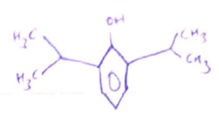K2i: The PD effects of propofol & how this influences its clinical usage
Property
Clinical Usage
Dose dependent effects
Sedation, anxiolysis, GA (induction, maintenance)
MoA
- ↓ rate of GABA dissociation from GABA receptors
- ↑duration of Cl– channel operating → cell membrane hyperpolarisation. Inhibits NMDA receptor by channel gation modulation (inhibits currents activated by NMDA)
Induction: 2mg/kg
Maintenance: 0.2mg/kg/min
Levels (mcg/mL)
- 3 = psychomotor effects
- 0 = sleep
- 4.0 = major surgery
CNS
- Rapid LOC
- Rapid emergence
- Amnesia
- No analgesia
- ↓CBF/↓CPP/↓CBF
- Useful for RSI
- Day surgery/short cases/neurosurg for quick new assessment/TIVA
- ↓adverse experience
- Needs opioid
- Suitable for neurosurg cases or HI/risk of space-occ lesions
CVS
- Local release NO → ↓↓SVR
- Negative inotrope
↓MAP monitoring required
Patient needs to be well filled
Caution in shocked states/bypassed/HF
Beneficial for patients with IHD
Resp
- Dose-dependent resp depression
- Impairs response to ↑PaCO2/↓PaO2
- Inhibits laryngeal reflex
- Bronchodilation
- Requires professionals skilled in airway management
- SpO2 monitor required
- Suitable for LMA insertion/airway instrumentation
- Suitable for asthmatics
GI
- Anti-emetic (?O2 antagonist)
- N&V refractory
- Suitable for patient @ high risk PONV
Other
- Pain on injection
- Does not cause MH
↓
- ↓intra-ocular P
- Requires lignocaine
- Suitable for patients as an alt. to inhalationals
- Suitable for eye surgery
TOXICITY
Propofol infusion syndrome
- Hepatic failure, rhabdo, severe metabolic acidosis, renal failure
- Minimise dose/infusion
- Rare fatal
- Critical children with Long T propofol infusion @ high doses
